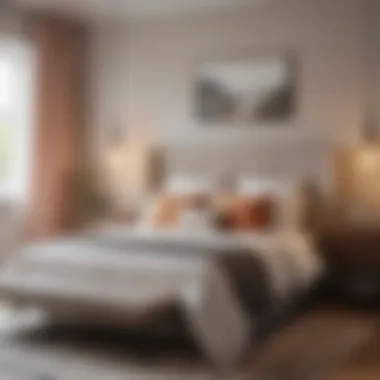Explore Stylish Two Tone Color Schemes for Bedrooms


Intro
Creating a harmonious bedroom environment can significantly enhance your overall well-being. Two tone color schemes are a practical way to achieve visual balance and tranquility. They allow for creativity while ensuring that the space remains calm and inviting. This exploration will take you through the essential components needed for using two tones effectively in your bedroom design.
Understanding the psychological influence of colors is the first step. Each hue can evoke specific emotions, affecting how you feel as you enter the room. For example, soft blues can promote relaxation, while earthy tones might bring a sense of stability. The art lies in pairing these colors wisely.
In this guide, we will address practical implementation, necessary materials, and technical aspects to elevate your DIY project. This approach not only aids in achieving your desired aesthetic but also ensures the process is enjoyable and fulfilling.
Understanding Color Theory
Color theory is essential in the context of bedroom design, as it helps create spaces that are not only visually appealing but also enhance the overall atmosphere of the room. Understanding how colors interact, convey emotions, and influence mood can guide homeowners in selecting color schemes that resonate with their personal style while promoting tranquility and relaxation.
The Psychology of Color
Emotions associated with colors
Colors trigger various emotions that can transform a space. For example, blue often evokes feelings of calm and serenity, which can contribute to a peaceful environment in a bedroom. Green represents nature and harmony, making it a popular choice for promoting relaxation. Yellow can bring warmth and cheer but may be less soothing. Knowing how different colors influence emotions allows individuals to choose pairings that align with their desired ambiance. In bedrooms, a careful selection of emotional triggers can enhance restfulness, making this knowledge especially relevant.
Color influence on mood
Colors have a profound influence on mood. For instance, soft tones like pastels can create a gentle, inviting atmosphere conducive to sleep. In contrast, bold colors can energize a space but may cause overstimulation in a bedroom setting. Understanding this dynamic is crucial for choosing two tone color schemes. Thus, selecting the right hues not only beautifies the room but can directly impact how one feels while spending time there. Understanding these aspects helps to cultivate a more harmonious living space.
Practical application in design
Applying color theory practically in design involves knowing how to pair hues effectively. This knowledge allows homeowners to create cohesive interiors that reflect their tastes. For instance, using a two tone approach can draw attention to architectural features or create depth in the room. The key is to be deliberate about color choices. The unique challenge of finding the right balance between shades can yield advantages, such as making the room feel more spacious or establishing a focal point, enhancing visual interest further.
Color Harmony and Balance
Color harmony and balance are vital when creating a bedroom environment that feels inviting. This means exploring various color combinations that complement or contrast effectively.
Complementary colors
Complementary colors are opposite each other on the color wheel, creating striking contrasts that can energize a space. For example, combining blue and orange can make a room feel dynamic. This choice may resonate well for more expressive home decor. The challenge lies in balancing these colors to avoid overwhelming the senses. When used correctly, complementary schemes can create a vibrant yet balanced aesthetic.
Analogous colors
Analogous colors sit next to each other on the color wheel. This approach fosters harmony and tranquility, which is essential in a space intended for relaxation, like a bedroom. Using blues, greens, and teals together can reflect a serene vibe. This is a beneficial choice for those who favor a soft and cohesive look. However, the key is to introduce variety through texture and patterns, preventing the design from becoming monotonous.
Triadic color schemes
Triadic color schemes involve using three colors that are evenly spaced around the color wheel. This technique brings balance and variety. For example, combining red, yellow, and blue can create a lively yet organized feel. This method is popular among those looking for a bit more intrigue in their design, yet it can become chaotic if the balance is not managed well. When executed thoughtfully, it can showcase individuality while retaining harmony throughout the space.
Benefits of Two Tone Color Schemes
Two tone color schemes offer a unique way to transform a bedroom. Their benefits are numerous and cater not only to aesthetic appeal but also to the satisfaction of emotional and psychological needs. Different combinations of colors create varied atmospheres, ensuring that each space has its own identity. This article looks in-depth into how these color pairings can enhance visual interest and promote a positive mood.
Visual Interest
Creating depth in a room
Creating depth in a room is essential to achieving a balanced and inviting atmosphere. Two tone color schemes help in visually expanding a space. By employing distinct hues for different walls or sections of the room, one can achieve a sense of dimension. Darker colors tend to recede while lighter ones advance, which gives the effect of a deeper room.
This technique is often used in smaller spaces that might feel cramped. By cleverly selecting two contrasting shades, the perceived size of the room can be altered. For instance, a darker blue on the lower half with a lighter blue on the upper half creates visual complexity. The unique feature of this approach is its versatility; it can work in various styles from modern to traditional, accommodating diverse personal tastes and styles.
Breaking monotony
Breaking monotony is critical, especially in personal spaces like bedrooms, where we spend much of our downtime. A single color can often feel uninspiring and drab over time. Two tone schemes introduce an element of surprise and can make a room feel more dynamic.


Using different tones can make areas within a bedroom feel distinct while remaining cohesive. For example, pairing a soft cream with a warm terra cotta creates a pleasing contrast that keeps the eyes engaged. The advantage of breaking monotony lies in how it sparks interest and ensures the bedroom remains a refreshing environment rather than a dull one.
Enhancing architectural features
Enhancing architectural features refers to the way two tone colors can draw attention to appealing aspects of a room. High ceilings or unique moldings can be highlighted through thoughtful color choices. For instance, painting the upper trim of a room in a lighter color can emphasize height and elegance, while a bolder color on the lower half grounds the room.
This specific aspect of color application not only showcases the strengths in a room’s design but also personalizes the space. Properly applied two tone strategies can elevate ordinary rooms into extraordinary spaces, making the unique features stand out.
Mood Enhancement
Promoting relaxation
Promoting relaxation is vital in a bedroom, a space intended for rest and rejuvenation. Two tone color schemes can encourage calmness and comfort. Soft colors like mint green paired with creamy white can create a serene environment.
The unique feature of this combination lies in its ability to evoke tranquility. Such palettes can help in lowering stress levels. This makes it a popular choice among homeowners seeking to create personal sanctuaries within their homes. It is an effective way to reinforce the bedroom's primary purpose of providing a restful environment.
Encouraging focus
Encouraging focus is particularly relevant in bedrooms that also serve as home offices. Two tone schemes can help delineate work areas from relaxation zones. A crisp white paired with a deep navy can establish a clear boundary between the two areas, promoting productivity without sacrificing comfort.
This characteristic is crucial in maintaining an effective home working environment. By using color in this way, it becomes possible to benefit from the balanced energy that comes from separating spaces without the need for physical barriers.
Fostering creativity
Fostering creativity through two tone colors is another compelling benefit. Bright colors combined strategically can inspire imaginative thinking. A vibrant yellow partnered with a muted gray can capture attention and evoke a sense of playfulness, essential for stimulating creativity.
Breaking the norm with bold combinations can encourage out-of-the-box thinking. However, overuse of highly saturated colors can be overwhelming, so balance is key. The careful application of adventurous palettes can help to create inspiring environments without causing visual chaos.
This exploration of two tone color schemes enhances both visual and emotional appeal, making bedrooms not only livable spaces but also sources of inspiration and comfort.
Choosing the Right Color Combinations
Selecting the right color combinations is crucial when designing a bedroom with two-tone color schemes. The choices not only influence the aesthetic appeal but also affect the overall atmosphere of the space. Proper color combinations can create a harmonious environment that reflects personal style and enhances comfort, contributing to a tranquil retreat for homeowners. This section will explore popular pairings and important considerations to guide individuals in making informed decisions about color selection.
Popular Two Tone Combinations
Neutral and pastel pairings
Neutral and pastel pairings provide a soft, serene look that is often favored in bedroom designs. The subtlety of pastels combined with neutrals creates a calm environment conducive to relaxation. This choice is beneficial because it does not overpower the senses, allowing for a restful ambiance. For instance, a soft lavender paired with a light beige can give an elegant touch to the room.
The unique feature of this combination is the ability to create an airy feel, making even smaller spaces appear larger. However, one disadvantage might be that it can lack personality if overly subdued shades are used. It is essential to find a balance that incorporates personal touches while maintaining the intended tranquility.
Bold and vibrant contrasts
Bold and vibrant contrasts bring a sense of energy to any bedroom. When carefully selected, these color pairings can make a striking statement. For example, deep navy blue paired with bright yellow can energize the space. This combination is appealing because it draws attention and can be stimulating, which may be desirable for creative individuals.
The key characteristic of this approach is the potential to evoke strong emotions and create focal points within the room. However, it can also be challenging to balance such vivid colors without overwhelming the senses. Consideration is needed to ensure the space remains inviting rather than chaotic.
Earth tones and cool shades
Earth tones combined with cool shades offer a grounded, natural feel in the bedroom. Colors like olive green next to soft blues can create a harmonious environment that connects with nature. This is a beneficial choice as it fosters a sense of calm and stability, making it ideal for spaces dedicated to rest and rejuvenation.
The unique feature of this pairing is its versatility, able to suit both traditional and modern aesthetics. Still, an over-reliance on earth tones could lead to a monotonous palette if not balanced thoughtfully. Striking a balance with texture and patterns can add dimension to the design.
Considerations for Color Selection
Room size and light conditions
Room size and light conditions play a significant role in determining the success of color combinations. Dark colors can make a small room feel more confined; thus, lighter shades might be preferable there. Good lighting can enhance color perception, so it's important to test how colors look in both artificial and natural light before making a final decision.


The essential aspect here is understanding how colors react under different lighting conditions. A beneficial choice often involves lighter or brighter tones in poorly lit rooms, bringing in more light and vibrancy that can uplift the overall feel.
Existing furniture and decor
Considering existing furniture and decor is another critical element in color selection. The colors of furniture can greatly influence the overall color scheme of the room. If a big piece of furniture is in a strong color, it may be best to choose complementary tones for the walls.
The key characteristic of this consideration is its integration with the current environment. Harmonizing with, or carefully contrasting, the furniture can enhance the uniqueness of the space. However, it's important to be cautious; mismatches can create an undesirable aesthetic.
Personal style and preferences
Personal style and preferences are fundamental to the entire color selection process. The bedroom is a private space, and reflecting true tastes can make the room more enjoyable. Identifying whether one prefers minimalistic and calm designs or bold and energetic styles is essential in choosing the right colors.
The unique feature of this aspect is the empowerment it offers to homeowners in expressing their individuality. However, the challenge could be finding a balance between personal preferences and universal design principles. Too much focus on trends and neglecting personal style can lead to dissatisfaction over time.
Techniques for Applying Two Tone Colors
Applying two tone colors in a bedroom is not just about aesthetics; it is a method to define space and mood. Techniques for applying two tone colors allow homeowners and designers to create a visually engaging atmosphere while maintaining functionality. Proper application techniques contribute to the overall design's effectiveness by ensuring that the colors work together harmoniously. This section will explore how to implement two tone colors effectively in your bedroom, helping you transform your personal space in a thoughtful manner.
Accent Walls
Selecting the right wall
Choosing the correct wall for an accent is crucial. Generally, the focal point of a room is a great choice. This method draws attention and emphasizes design elements. Accent walls help break the monotony of a single color dominating the space. However, it is vital to consider the layout and dimensions of the room when selecting which wall to style.
A common characteristic of selecting the right wall is its role in creating depth. When a wall acts as a backdrop for furnishings or artwork, it enhances the visual appeal of these items. The disadvantage may be that if too many walls are colored, it can create a fragmented appearance. Therefore, balance is essential.
Application methods
The way paint is applied can influence the final look of a two tone effect. Different application methods yield varied results. For example, using a straight line technique offers a clean separation between colors. In contrast, sponging can produce a soft transition. This versatility allows for greater creativity in design.
Additionally, the method affects the time and effort required for project completion. Easy application methods like using painter's tape can minimize mistakes. However, more intricate techniques may require a deeper skill level, demanding precision. Choosing the right method is integral to the desired finish and overall ease of application.
Choosing accent colors
The process of selecting accent colors holds significant weight in two tone design. The right accent colors should harmonize with the primary color of the room. It could be complementary or analogous shades that evoke the desired mood. A subtle contrast can energize a space, while similar tones often create a serene environment.
One key feature of this selection process is the ability to reflect personal style. It allows you to express individuality and sophistication, influencing how the room feels to those who enter. However, an overly bold choice might overpower the intended ambiance, so moderation and consideration are necessary for success.
Two Tone Furniture
Painting techniques for furniture
Furniture can also benefit from two tone color schemes. Painting furniture adds unique character and flair to a space. Techniques such as distressing or ombre finishes can yield results that range from casual to sophisticated. These methods contribute to the overall aesthetic of the bedroom, adding layers to the design.
An advantage of using paint is versatility; one can easily modify furniture over time without needing to invest in new pieces. However, it requires a commitment to maintenance, as painted surfaces may chip or fade. Therefore, careful planning in selection and execution will be essential for long-lasting results.
Combining textiles and colors
Integrating textiles with color schemes is equally important. The selection of textiles should complement the color palette used in the room. This integration can bring warmth and coziness to the two tone effect. It enhances tactile experience and visual depth, making the space inviting.
One significant characteristic is texture variety, which can greatly impact the visual perception of colors. This means layering different fabrics can harmonize or contrast effectively. However, mixing too many patterns or colors may induce visual confusion. Limit the palette to ensure a polished appearance without overwhelming the space.
Strategic placement in the room
The placement of elements colored in two tones should be thoughtfully considered. Strategic placement involves positioning color elements to enhance flow and functionality in the room. For example, color accents on a bed frame can enhance the visual interest of bedding or wall colors, while strategically placed chairs with a different color can create an inviting nook.
A significant consideration is the cohesion of design elements throughout the room. Achieving balance between different colored pieces fosters a sense of unity. Nevertheless, overly ambitious placements might disrupt the visual harmony; hence it is essential to consider how these elements interact within the broader design context.
Overall, techniques for applying two tone colors are crucial for achieving a cohesive look in the bedroom while reflecting the homeowner's personal taste.


Maintenance and Longevity
In order to maintain the beauty and effectiveness of two tone color schemes in the bedroom, it is essential to consider both maintenance and longevity. These factors ensure that the design remains visually appealing over time and that the paint and decor elements stand the test of daily use. A well-maintained bedroom not only reflects personal style but also enhances relaxation and comfort. To achieve this, careful attention must be paid to the materials chosen, their durability, and how they are cared for in the long run.
Choosing Durable Paints
Types of paint finishes
The type of paint finish you select can significantly impact the longevity of the color scheme. There are several options, including matte, eggshell, satin, and semi-gloss. Each finish has distinct characteristics. For instance, satin and semi-gloss finishes are often preferred for bedrooms. They offer a level of sheen that not only looks good but is also easier to clean. In contrast, matte finishes can display imperfections more easily but can create a beautiful soft look. Understanding these options allows homeowners to choose finishes that align with both aesthetic desires and practical needs.
Longevity of color schemes
Longevity is a critical factor in two tone color schemes. Choosing colors and finishes that are durable will help maintain their vibrancy. For example, using high-quality paints that resist fading in natural light helps keep the bedroom looking fresh. Additionally, incorporating colors that are less prone to showing dirt or wear can extend the life of the aesthetic. A well-chosen scheme can last years without needing significant updates, making it a worthwhile investment in bedroom design.
Environmental considerations
When selecting paints, environmental considerations come into play as well. Eco-friendly paints with low volatile organic compounds (VOCs) are becoming more popular. They are better for health and contribute to a sustainable choice. Furthermore, many of these paints are durable and can withstand the test of time. Opting for environmentally friendly products means homeowners can ensure a safe space while enjoying aesthetic benefits.
Caring for Two Tone Decor
Cleaning techniques for color preservation
Proper cleaning techniques are vital for preserving the colors in a two tone scheme. Using gentle, non-abrasive cleaners helps to maintain the integrity of the paint. Regular dusting and spot cleaning can prevent buildup that dulls the appearance. Different finishes may require specific cleaning methods, so always check the manufacturer's instructions for guidance. This approach keeps the colors vibrant and fresh.
Addressing wear and tear
Addressing wear and tear is essential for maintaining the initial appeal of two tone decor. Regular inspections for scuffs, scrapes, or chipped paint can prevent small issues from becoming larger problems. Touching up paint as needed ensures that walls look consistently polished. Additionally, paying attention to furniture and other elements within the bedroom helps keep everything aligned with the overall design.
Periodic updates to maintain style
Periodic updates can also enhance the longevity of the two tone color scheme. While the color scheme itself may not need constant change, updating accessories, artwork, or textiles can breathe new life into the space. These smaller adjustments can keep the bedroom feeling fresh and aligned with evolving tastes and trends. It is a simple way to ensure the aesthetic remains current over time.
"Maintenance is as much about the long-term results as it is about immediate satisfaction. A careful approach in the beginning can pay dividends in how you enjoy your space later on."
Case Studies and Examples
The exploration of case studies and examples provides practical insight into the application of two tone color schemes within bedroom design. Analyzing real-world implementations allows readers to visualize how theoretical concepts translate into actual spaces. It also highlights the aesthetic variances between styles and shows the impact of color selection on atmosphere and personal comfort. Through these case studies, homeowners can gain inspiration and a deeper understanding of how to create their unique sanctuary.
Contemporary Bedroom Designs
Minimalist approaches
Minimalist approaches prioritize simplicity and functionality, focusing on essential elements. This is particularly significant in tight spaces where clutter can overwhelm. The use of two tone colors can augment this style by defining areas without compromising the sense of openness. A key characteristic is the selection of neutral palettes, often combined with natural textures. This not only creates a coherent look but also is a beneficial choice for achieving relaxation and clarity in the bedroom. The unique feature of these approaches is its adaptability; they suit various personal styles while promoting a calm environment. However, the challenge lies in ensuring that simplicity does not lead to a sterile feel.
Maximalist expressions
In contrast, maximalist expressions embrace bold colors and patterns. This style encourages experimentation and creativity, providing a rich tapestry of visual elements. One noticeable characteristic is the deliberate use of contrasting tones that evoke energy and dynamism. It is a popular choice for individuals seeking to showcase personality through design. Unique to this approach is its emphasis on layering diverse textures and colors, resulting in an eclectic yet harmonious environment. While this can create a visually stimulating space, a potential disadvantage is the risk of overwhelming a small room.
Transitional styles
Transitional styles serve as a bridge between traditional and contemporary designs. This aspect contributes a sense of balance and cohesiveness, especially when integrating two tone color schemes. A defining characteristic is the reliance on soft color transitions that create a seamless flow between spaces. This makes it a beneficial choice for those who appreciate the comfort of traditional design but also desire modern aesthetics. The unique feature is its versatility, allowing for customization in terms of color, texture, and furniture style. However, another consideration is maintaining the harmony without leaning too much towards one style over another, which might disrupt the intended effect.
Retro and Vintage Inspirations
Classic color pairings
Classic color pairings celebrate timeless combinations that evoke nostalgia. They typically include soft blues, creams, and earthy tones, which can contribute to a warm and inviting atmosphere. This aspect makes them appealing for creating a cozy bedroom environment. A noteworthy characteristic is their ability to blend seamlessly with various decor styles. This versatility renders classic pairs a consistent choice, as they age gracefully while retaining relevance. The unique feature is how they can spark fond memories while also being adaptable in modern contexts. However, the risk involved is that these pairings may appear outdated if not styled with contemporary elements.
Materials and textures
The incorporation of various materials and textures plays a vital role in enhancing overall design. Different materials can elevate the visual experience, adding depth to the color palette. A key characteristic here is the way soft fabrics and hard surfaces interact, enriching the aesthetic. For two tone schemes, this choice can create layers that engage the eye. It allows for creativity and personalization, making it a beneficial option for designing a unique space. The unique feature is the tactile quality it brings to a room. Yet, the challenge is to ensure these materials complement rather than clash, which could confuse the overall vision.
Preserving nostalgia while updating
Preserving nostalgia while updating involves maintaining classic elements while introducing contemporary features. This strategy enhances the room's character while ensuring it feels fresh. A central characteristic of this approach is the blend of vintage pieces with modern designs, providing a unique visual narrative. This makes it appealing for those who want to honor their past while embracing the present. The unique feature is how it creates a story within the space, reflecting personal history intertwined with current trends. One potential downside is that achieving the right balance can be challenging, potentially leading to a disjointed feel if not executed thoughtfully.







